A History of the Roman Catholic Church in Runcorn
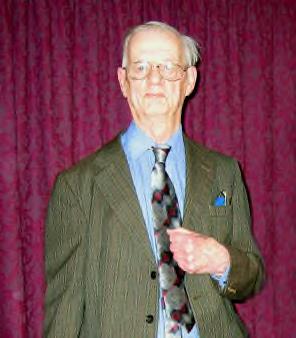
The Late Mr.Bert Starkey
The present church of St. Edward was completed 50 years ago. It replaced one which was built in Irwell Lane in 1888. The latter replaced the original St. Edward’s which was built in 1846. So the Ivy Street church is the third Catholic church dedicated to St. Edward – the third Catholic church to be built in the town since the Reformation in the sixteenth century.
But by a remarkable coincidence when the first St. Edward’s was built in Windmill Street in 1846 the ancient medieval parish church where mass had been celebrated for centuries was still standing. It was demolished in the very year that the Windmill Street church was opened.
So there has been an overlap of Catholic places of worship in Runcorn – an unbroken chain going back for over a thousand years. There are some who think that Catholicity in Runcorn began with the construction of the first church early in Queen Victoria’s reign. However there has been a Catholic place of worship in Runcorn since before the Norman Conquest.
The title of my talk is "A History of the Church in Runcorn." I have 42 slides to illustrate the story.
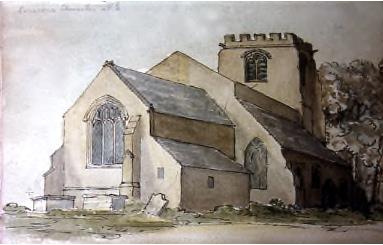
Today’s All Saints Anglican church in Church Street stands on the exact site of the old pre-Reformation church. All Saints dates from 1849. It was completed 3 years after the demolition of the old 13th century building.
The first illustration is a water colour painting of the old church which was executed by a Mr. Allen who was a curate of the parish church. A suggested date for the painting is 1820. This is a view from the north-east. If you were walking along what is now Mersey Road this is the view you would see. The old church was built on what is known as Early English style of architecture and it was built about 1240. Originally the church was dedicated to St. Bertelin, an obscure Mercian saint from Derbyshire who lived in the late 9th century. At an unknown date the name was changed to St. Bartholomew and so it remained until its demolition in 1846. For centuries it was the only substantial building in Runcorn village.
In this picture the church appears to be an attractive village church but when the painting was made it was in a terrible state of disrepair. Much of it was over 600 years old. Poor maintenance over the centuries and shoddily built alterations had resulted in the building becoming unstable. The tower had a dangerous overhang, the mortar was perished and the masonry was loose. However, in spite of its precarious condition the tower could not be taken down as this would bring about the complete collapse of the church! By 1820 the tower was so dangerous that the bells could not be rung. Repairs to the roof could not be undertaken because if the heavy roof slabs were removed the walls would fall. The south side was patched up and a jerry-built insertion was beginning to subside. The old church was an eyesore, a crumbling edifice but Runcorn was a poor village and there was very little money to pay for essential repairs. It was only when the town began to grow with the coming of industry that sufficient funds were available to build the present church – now called All Saints.
The following illustrations are of the old medieval Catholic church.
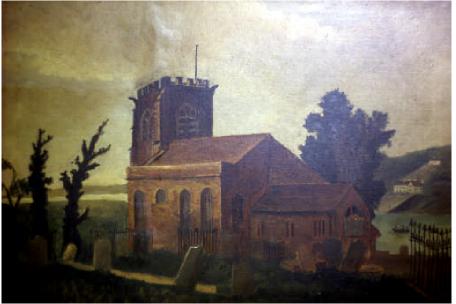
At the time of demolition the east window still retained some fragments of ancient glass. All the other coloured glass had been smashed out at the Reformation or a century later during Parliamentarian rule – the wreckers claimed that they did this “in order to let in God’s heavenly light”. All over England symbols of Catholic practice were removed; statues, wall paintings, stone altars and carvings were destroyed and over the centuries many changes were made to the interiors of buildings. We will go inside the old church in a moment. When the old church was closed in 1846 it was probably the third building on the site. Runcorn was founded in 914 by Princess Ethelfleda as a defensive position to deter Viking longships from passing up the river. Without doubt at the same time a church was built to serve Runcorn settlement. This would have been a wooden building which was later replaced by one of stone.
The removal of this old building in 1846 ended a tradition which lasted for more than 930 years.
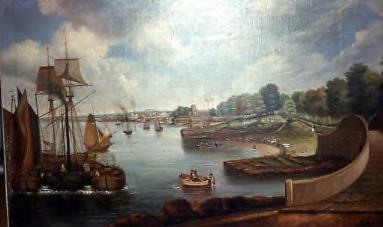
A view of the old church seen from the west about 1830. There was parkland where Southbank Terrace, Greek Street and Lord Street are today. Industry was beginning to appear. Early paddle steamers are on the river. This is Runcorn in transition. Every vestige of medieval Runcorn has gone – only the early church survives.
The churchyard had been in use for 1000 years when it was closed in the early years of the 20th century. It was at one time the only consecrated ground for many miles. Runcorn church was the mother church of a very large parish. There were chapels of ease at Daresbury, Halton, Aston and Thelwall.
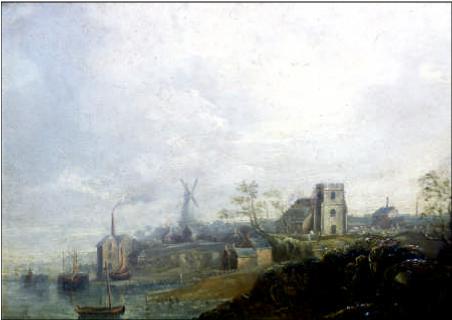
Another view from the west. Note the windmill in Windmill Street and the steam flour mill on the water’s edge. Runcorn was once a spa town and holiday resort. There are salt-water baths below the church.
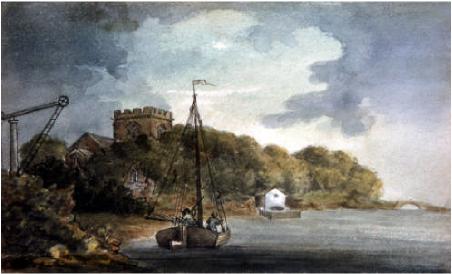
A view from the east. Also to be seen is the Ferry Hut where the equipment for the ferry boat was kept. The trees were said to be a very attractive feature. There was uproar when they were felled in the 1830s.

An amateur painting of the old church viewed from Church Lane (now Church Street). Notice the round-headed windows of an early 19th century addition which was poorly built and was sinking. Once there were many great yew trees in this churchyard which were said to be over 1000 years old. It had been used as a burial ground since Ethelfleda’s day.
Runcorn was entirely rural in the early nineteenth century with a population of only 1,330. Note the busy river traffic.
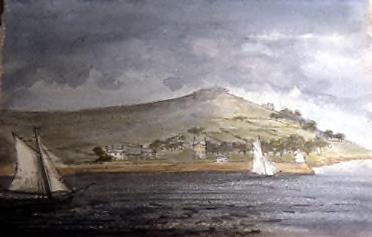
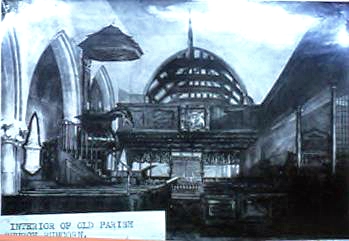
Although the old parish church lasted until the early years of photography, it appears that no pictures have survived. However this may be an early daguerreotype photograph of the interior. By 1846 nothing remained of Catholic practice except the rood screen. The pulpit dates from the 17th century and the box pews from the 18th century. The flag is from Napoleonic times. The wall plaques commemorate vicars from Georgian times. Even the architecture has changed. On the north side it is original from the 13th century; on the south side is the extension of 1802.
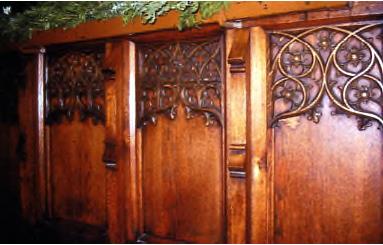
The destruction of the old church was almost total. However 20 fragments of the old rood screen were salvaged to decorate the present choir stalls. They suggest 15th century tracery of the perpendicular style. The destruction of the screen was a tragedy – a great loss.

This is a photograph I took after a harvest festival nearly 50 years ago.
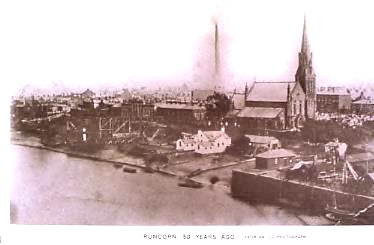
This photograph shows Runcorn in 1875. From a small insignificant village, the place has grown into a bustling, sooty little industrial town.
Before 1820 I doubt if there were a dozen Catholics living in Runcorn. Mass attendance meant crossing by the ferry, then walking to the mass centre in a farmhouse in Lowerhouse Lane near to where the Widnes Rugby League ground now is. Later, mass was celebrated in a house in Appleton village near the present St. Bede’s church. It was only after 1845 with the great famine in Ireland that the population of Runcorn and Widnes showed a substantial increase with the arrival of Irish Catholic labourers who sought work in the new factories.
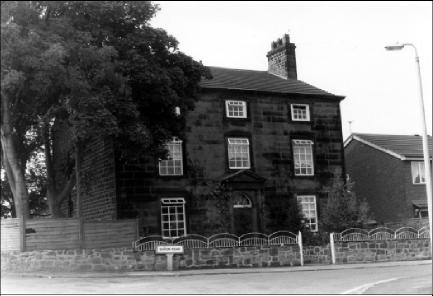
This is a photograph of Stenhill House in Saxon Road. It became the lodging of Fr. Edmund Carter who established the mission in the town in 1842. Runcorn mission was attached to the Catholic missions at Northwich and Middlewich. Fr. Carter remained in Runcorn for one year before he was succeeded by Fr. Gerald Ward. As there was as yet no church, services were held in a hay loft which was situated somewhere in Heath Road. It is said that mass was celebrated in Stenhill House.
By 1845 the Catholic population was growing as Irish labourers arrived to work on the farms and on the docks and inland waterways. They were held in contempt and despised by the locals. Some factories had a policy of not employing Irish folk. The newcomers were desperately poor. They lived in the poorest housing – the Rookery. It was alleged that they brought disease and crime. The Warrington Guardian of the 1850s does not disguise its feeling of contempt for Irish families; anti-Catholic feeling was general throughout the region. There was no school for Catholic children; they were regarded as unwelcome immigrants.
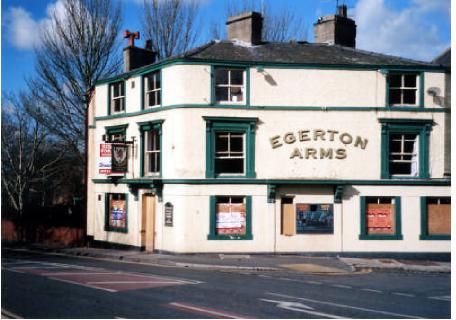
Over 50 years ago I met an old lady who told me that her grandfather attended meetings of Catholic parishioners in the Egerton Arms. I doubt that mass was ever held in the premises but social meetings might have been held in the big room. The Egerton Arms was demolished earlier this year.(2007)
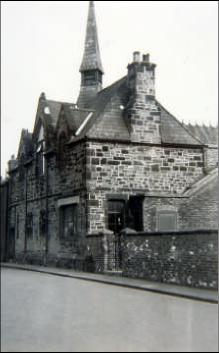
In 1846 Fr. Ward built the first St. Edward’s in Windmill Street. It was made of local stone, quarried in what is now Rock Park. About 50 years ago I interviewed Mr. John Durr who served as an altar boy in this church in 1887 when he was 11 years old. He later served in the Irwell Lane – the “tin chapel”. He was invited by Fr. Turner to serve mass when he was an old man in the present church. Mr. Durr was proud of his achievement and he described the Windmill Street church when he was a scholar there – for by 1887 it was a school-church.
The church interior had large black and red quarry tiles on the ground floor. The walls were whitewashed. There was no heating whatsoever and no carpets. The church was lit by gas jets. There was a wooden altar but no side altar.
In 1866 the church served a dual purpose when the upper room, the parochial meeting room, became a schoolroom. Here there was an open fire. St. Edward’s chapel school operated for 28 years. As the congregation increased, so did the school roll until it became necessary to find another site for a church. The church was then solely occupied by children.
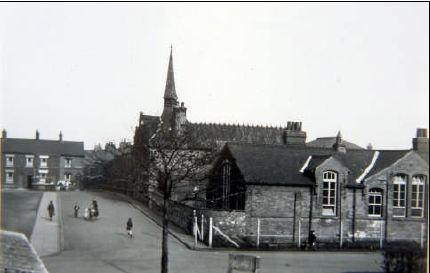
A view of the church looking along Windmill Street. The new building in the foreground was occupied by the infants and it was built in 1904.

The aspect from the east. Four classes were accommodated in the building and when I was appointed in 1948 there were 124 children on the school roll. Of course the building was adapted to educational purposes but it retained certain ecclesiastical features. Holy water stoops, Gothic windows and one fragment of painted glass which was incorporated in the new St. Edward’s school in Wyvern Place.

The chancel; the boys’ cloakroom with interesting slate patterns. The school underwent rebuilding about 1966. Note the gas-fired flue; previously there was coke-fired central heating..
Removal of the steeple and other alterations made for an ugly building. New floors were installed. By this time the classes were large and many neighbouring Sunday school rooms were pressed into service as classrooms. The old building was demolished in 1981 to make way for a new road.
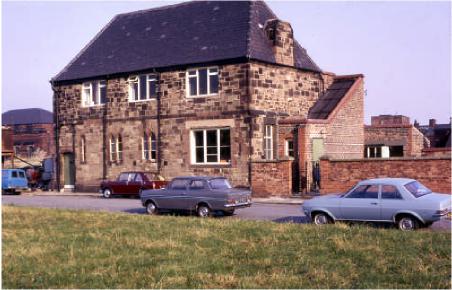
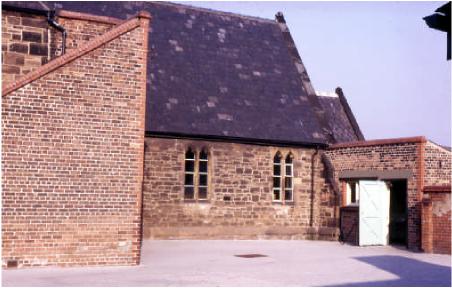
Evidence of alterations to make the church suitable for school purposes. An outside staircase has been added to the upper classroom.
A fine new St. Edward’s primary school has now been built in Wyvern Place.
This shows the old choir gallery boarded off to serve as a cloakroom. In Victorian times mass was celebrated on Sundays at 9.00 am and 10.30 am with Benediction at 6.30 pm. The headteacher played a harmonium to accompany singing – no mass on weekdays. Mr. Durr told me that for some years the priest came from St. Michael’s in Ditton, Widnes. There was no resident priest but at one time the priest lodged in Bold Street.
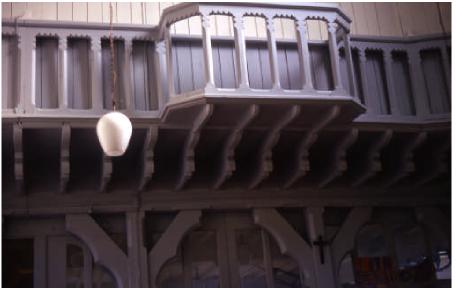
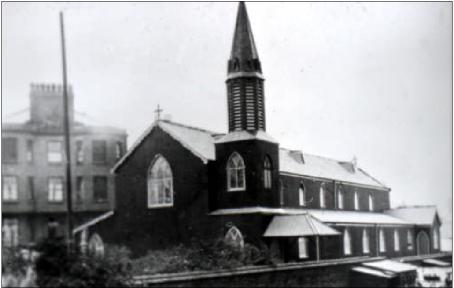
The Windmill Street chapel was abandoned to classrooms in 1888. The new church in Irwell Lane was constructed using corrugated iron sheeting. It was realised that the building was a temporary structure; in fact it lasted 68 years. This second St. Edward’s had a steeple. This was removed and the building had the familiar appearance that many of us remember. In the background can be seen a Georgian house which became the presbytery. It has now been modernised to become Irwell Court.
The interior of the “tin church”. The altar is rather plain because a severe fire in 1945 destroyed the chancel and because of war-time shortages, few materials could be found to restore it to its previous attractive appearance. Over the years the temporary nature of the building resulted in many problems as the roof and walls began to deteriorate. The roof needed constant repair and in 1926 the Young Men’s Society, under the leadership of Fr. Jones and his curate, Fr. Calderbank, set to work to replace the old iron cladding with asbestos tiles and sheeting. The appeal for funds for the repairs raised £600 of which about £100 was contributed by non-Catholic friends.
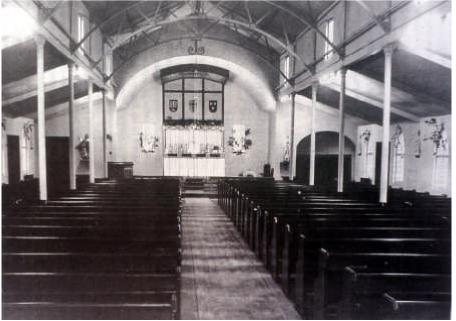
For a time after the fire in 1945 the church could not be used and services were held in the old clubrooms and later in the Citadel, the Salvation Army headquarters, in High Street.
When the new church in Ivy Street was opened the old church was used as classrooms – as an overflow from Windmill Street school. By this time the school roll had grown to 570, from 124 in 1948. The Irwell Lane church was not a suitable building for classrooms and was condemned as a fire risk. There was nowhere for the children to play.

St. Edward’s was famous for Whit processions. The Procession of Witness commenced at the school and crossed Delph Bridge to the church. It was very impressive with all the children taking part. The procession always attracted many spectators. As with all such events in Britain, this procession faded away because of the increase in traffic. Occasionally one hears of small token “walks”. This shows a procession in the 1920s or early 1930s.
The men of the parish in around 1930. I have the names of all those in the photograph. Perhaps you recognise some of them, including Fr. Jones and Fr. Calderbank. They, no doubt, took part in the reconstruction of the church.
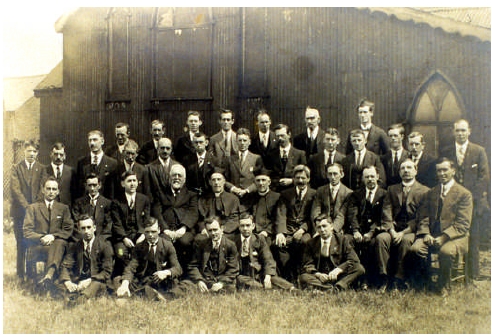
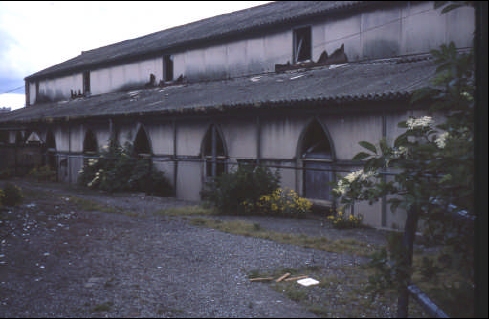
The Irwell Street church awaits the bulldozers. The Busway now passes through the site. There is not a trace of the first two churches dedicated to St. Edward.
During the construction of the Manchester Ship Canal in 1887-1894 Runcorn’s population was increased by 6,000 as the navvies and their families settled in the town. Many were Catholic and St. Edward’s school could not cope with the demand for places. In 1889 a small Catholic school was built in Weston village. It was to have a short life for when the canal was finished, the workforce moved on and the roll of Weston school fell until it was no longer viable. It closed in 1902 having had a life of 13 years.
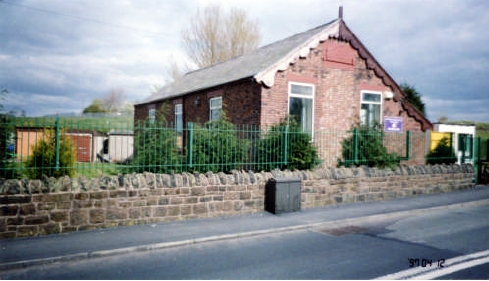
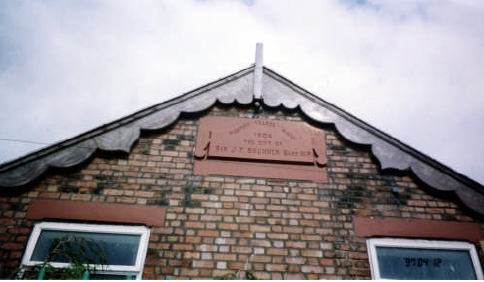
The school was bought by Sir John Brunner who presented it to Weston village to serve as a village hall. The building became the headquarters of the Weston scouts. A few years ago it was discovered that gases from the infill of an old quarry were leaking into the building and, together with a number of houses in Weston, the school was demolished.
This is the foundation stone bearing the date of 1888.
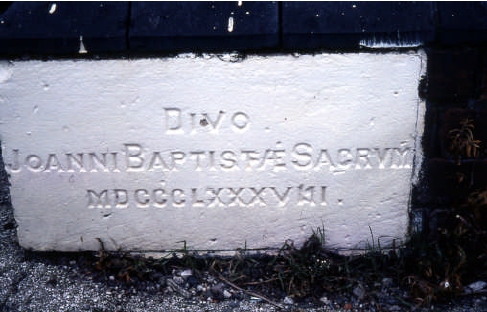
and this is how the Weston school site appears today (2016).

Clergy accompanying a school trip to Frodsham in the early 1930s. The famous helter-skelter can be seen in the background.
St. Edward’s was one of the last all-age schools in Britain. All the children from the infants to the senior boys and girls took part in the May processions together with Brownies, Guides, Cubs and Scouts. The processions were led by a brass band, often that of Nazareth House orphanage in Ditton. Following Our Lady’s statue was the May Queen and the train bearers and maids-of-honour. A boy has the honour of acting as crown-bearer and he carried the crown on a white cushion. It was a most impressive sight. The youth movements carried banners and the girls carried posies. It is now but a memory.
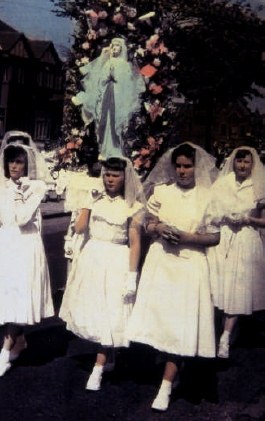
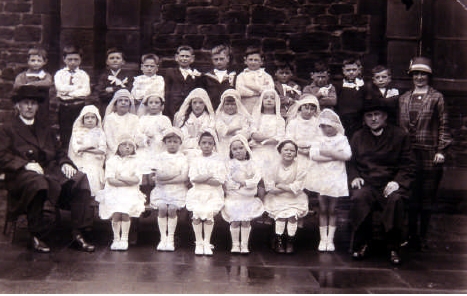
A picture perhaps from the late 1920s. Miss Quirk, the school’s headmistress, is standing on the extreme right.
Class sizes were beginning to increase. Mr John O’Neill with his class. His family came from Runcorn. His grandmother lost 3 sons in World War I.
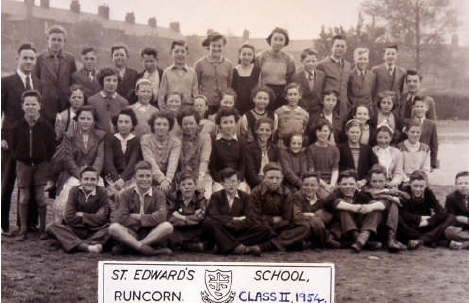
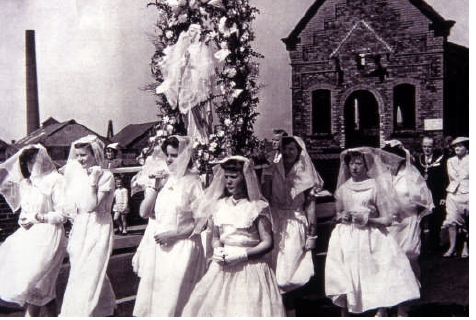
A procession to the new church is seen in Victoria Road en route to the new St. Edward’s church.
Fr. Joseph Briscoe with the Junior school staff in 1950. Four teachers and the headteacher were sufficient to staff the small school of about 140 pupils. Seen here are Mr. L. Ludden, Fr. J. Briscoe, Mr. H. Starkey, Miss A. Schola, Mr. F. Cox (headmaster) and Miss A. Doohan.
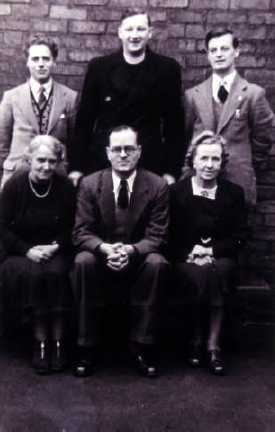
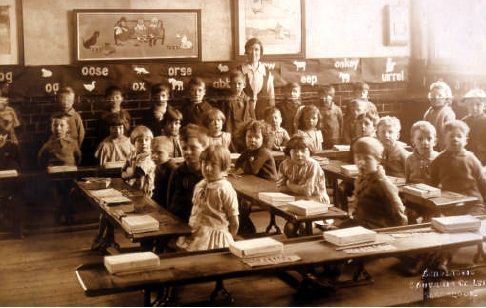
The infants’ class in 1929.

A class of 1952 pictured outside the old Windmill Street school.
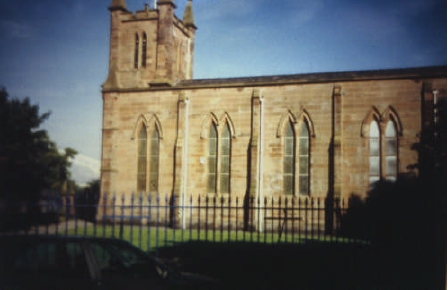
In March 1998 St. Edward’s new church suffered severe damage in a storm. The building could not be used and on Saturday 21st and Sunday 22nd mass was celebrated in Holy Trinity Church of England church. Two funerals of St. Edward’s parishioners were held in Holy Trinity church.
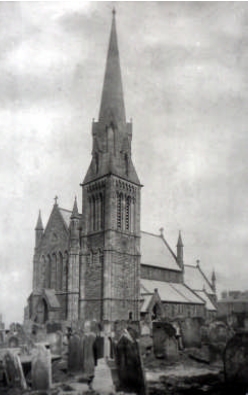
A Catholic service was also held in All Saints Church of England church.
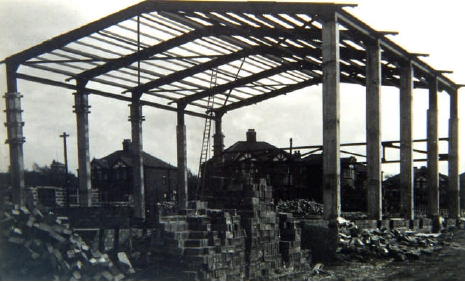
The steel frame of the new St. Edward’s church in Ivy Street is seen in this photograph of 1955.
The first services were held in the October of the following year. The new church has greatly enhanced its surroundings. A parochial room has since been added to the building.
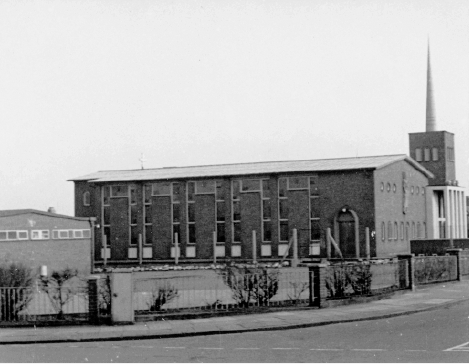
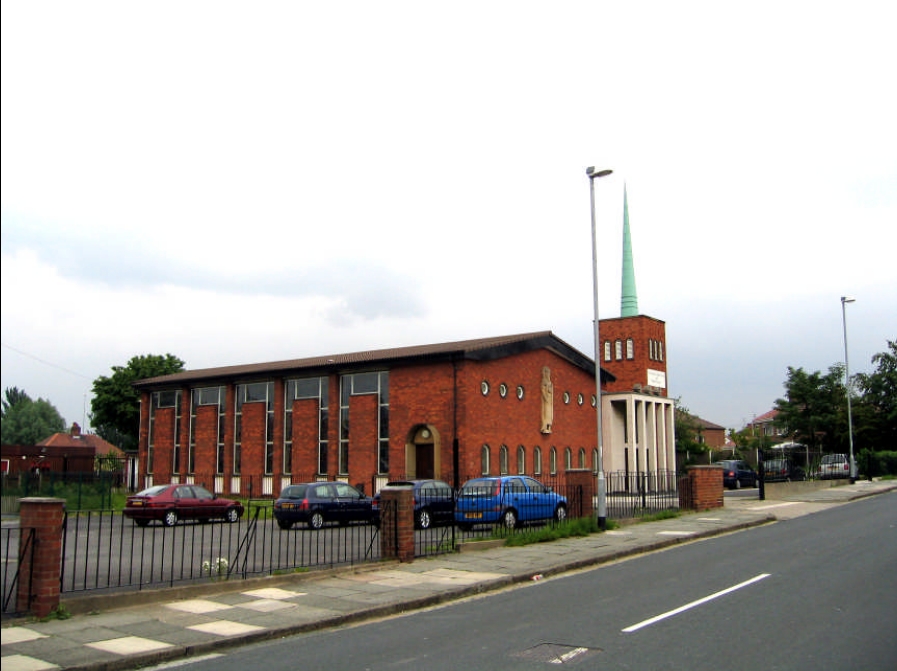
St.Edwards today
Since the completion of St. Edward’s church in Ivy Street, four new Catholic churches have been built in the New Town of Runcorn. Each has an adjacent primary school.
Today (2016) St.Edwards is one half of the Parish of St Maximilian Kolbe, Holy Spirit Church is its partner in the Parish.